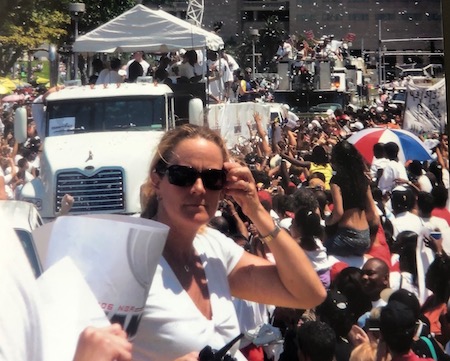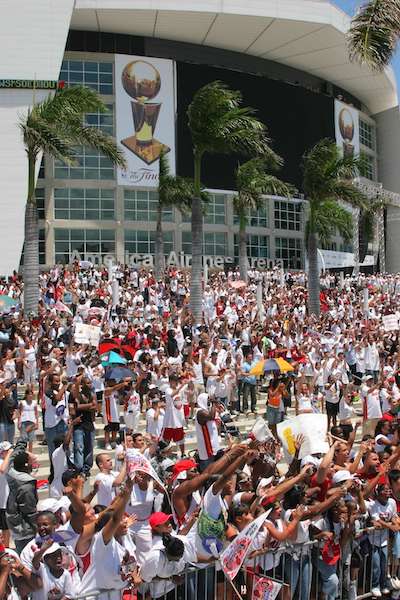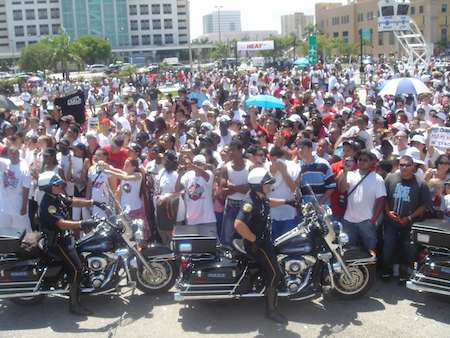In 2006, five months into her new job as executive VP and GM of AmericanAirlines Arena in Miami, Kim Stone had to plan an NBA championship parade — in 72 hours.
It did not go well. There’s nothing in her storied career in venue management, which has led her to manage Chase Center in San Francisco, “that beats the parade.”
It was June. The Miami Heat of the National Basketball Association, featuring a young star named Dwyane Wade and a proven superstar Shaquille O’Neal, were the unexpected winners of the 2006 NBA Championships, beating the Dallas Mavericks.
“We won in Dallas. The organization had flown the staff to Dallas, so I was there for the game. What a great memory. What a kind thing for the organization to do,” Stone begins, warming up to the saga of her life.
In true Pat Riley fashion, the coach had anticipated the Heat would win and had planned a celebration at the resort where the players had been staying in Dallas. So the team and staff didn’t go straight home after the final game. They went to the resort to celebrate.
Interestingly, the resort only offered champagne for the celebration and, at 2 a.m., there was no way to get a glass of wine for Stone, who gets horrible headaches from champagne. “That was one of the favorite nights of my life. Everyone around me was having so much fun, and so was I, but they had joy juice. Pat and Shaq were dancing together. They were just hilarious.”
Stone and her Chief Marketing Officer, Michael McCullough, who doesn’t drink, were the sober ones, which turned out to be a good thing the next day.
The flight back home was just as hilarious and exuberant. It was such a crowning achievement for everybody. “The joy and the emotions and excitement are like nothing you can replicate or get any other way,” Stone realizes.
“On that flight, Michael and I were told that we needed to meet with the city and county to talk about our parade plans. We didn’t have any parade plans,” Stone says.
Two factors conspired to cripple them: It leaked that Dallas had anticipated winning and had made a parade plan prior to the final game, which fired up the Heat locker room, particularly Dwyane; and that was the year Stone found out the city of Miami no longer planned or paid for championship parades, a reaction to the recession.
“We were forbidden from even talking about celebrating a win, even internally” lest they jinx the players, Stone remembers.
When they land in Miami, McCullough and Stone go directly to a meeting with the city. “I went with my championship hat pulled over my head because I looked horrible,” she says. “In my memory there were probably 300 people in the room, people who usually put on a parade for the city or county. They started peppering us with questions.”
“What time is the parade? What are your plans? How many people are you expecting? How many floats? How many police?”
“Hey, wait, aren’t you going to do the trash pickup, aren’t you going to assign the police?”
“No, no we don’t pay for it anymore. It’s all you.”
“We’ll get back to you.”
To add to their angst, Stone and McCullough knew that Pat Riley wanted a parade down Biscayne Boulevard, not Flagler Street per city tradition. Flagler Street is a bustling little two-lane corridor and there were past plans in place for that parade route. But when Riley became coach of the Miami Heat in 1996, he said he couldn’t wait to do a parade down Biscayne Blvd. AmericanAirlines Arena is at 601 Biscayne Blvd.
At the time, Stone was thinking he’s new, he doesn’t know it’s a Flagler Street parade. But that’s okay.
What a difference a decade makes. It was time to uphold Riley’s vision.
Being novice parade planners with 72 hours to pull it off, they did their best. Stone had to source barricades, the cops, all of the operations and logistics, how many people they’d allow, what the route would be, where the toilets were going, positioning the First Aid station and who would handle First Aid, how to organize the party outside. She and her team handled timing, ticketing and credentialing. McCullough focused on the team and getting the floats sourced and decorated.
“As you can imagine, we didn’t quite have a comprehensive plan in place. We did our best, but we didn’t have enough time,” Stone recalls.
The morning of the parade, she had gone home at 4 a.m. to take a shower and came right back. The parade was starting at 10 a.m. and she was walking the property to see if all the equipment was set and in place when she came across a Heat fan in a wheelchair.
“I’m so excited. This is the first championship for the Miami Heat in its history. Where is your ADA section?”
“I immediately made one up. He had the best view of everything from our last-minute ADA platform.”
She was doing things on the fly. It got worse.
“I remember at one point, somebody I respect in the organization came up and said, ‘Oh, Kim, don’t worry, it will be fine.’
“Don’t you dare tell me that everything will be fine when I started off the day without an ADA platform for somebody! Don’t pander to me at this moment. I’ve got to go.
“There is nothing about this that is okay. We’re never doing this again.”
When it came time to load the floats with players and families, her team was dealing with all the areas they didn’t plan out.
“You’re just running down there and grabbing people in. You’re reacting to the moment, which I hate. No one in events like to be reactive.”
But things started to calm down and the parade was about to begin. At her team’s urging, (“Yeah, go go. No big deal, no big deal.”), Stone climbed aboard the executives’ float and they rolled.
Stone’s mind was still racing, however. One of her biggest concerns was the ramp on the west side of the building, where they would have the post-parade ceremonies. It looked solid but was actually hollow underneath and had a limited weight load. She knew if people gathered on that ramp to see the parade, it would collapse. Ops Director Jim Spencer was assigned to protect the ramp.
It was a hot, clear summer day in Florida and everything was calm when the parade began, 20-30 floats, with Dwyane on his own, Stone and staff about four floats from the end.
And then the parade does the U-turn.
“There’s a reason you don’t do U-turns in parades,” Stone learns.
Biscayne Blvd. is four lanes on each side with a large median which includes parking in the middle. It’s easily 200 feet across. The parade route left the arena going south, made a U-turn and came back to the arena going north. So, of course, everyone who was lined up on the route leaving the property just pushed through the barricades and joined the people who had lined up on the northbound side to see it again.
To top it off, Shaq decided to “walk among the people,” so he jumped off his float.
“We lost control of the street. It was a sea of people. You’ve got these 16-wheelers, with tires as big as people, and people are pushing up against the floats.”
Stone is watching things unravel from the executives’ float.
“Somebody is going to die. We are in trouble. I’m talking to the police chief, saying ‘we’ve got to get this done, get them back,’ so they sent out motorcycles to re-create the barricades so the floats could pass through.”
Meanwhile, Stone jumps off her float and is running back to the arena. “I’m thinking if we lost the street, we’ve lost the building and our ramp is threatened. We’re going to have a structural collapse.”
On the radio, she shouts to Jim Spencer:
“Jim, Jim, how’s the ramp? Did we lose the ramp?”
“No, I’ve got it, Kim. We’re okay.”

When she got to a distance where she could see the building, she saw a sea of people and the only place people weren’t teaming was the ramp.
On the radio, screaming: “I love you Jim Spencer.”
To this day, people ask her, “Do you remember when you told Jim you loved him?”
Spencer’s team had brought out bike racks, formed a line in front of the ramp and proceeded to make deals with fans, who were hot and thirsty.
“If you stay here, we’ll bring you water, we’ll let you go in to use the bathroom, we’ll spray you down with the hose.”
“Deal.”
They got everybody to comply by giving them good service.
Dwyane’s float was the last one they needed to get back onto the property so he could be brought inside the arena. But the driver of that 16-wheeler took the wrong lane and when he needed to make the tight turn to get to the point to drop Dwyane off, there were lots of police cars illegally parked around the building. The driver just stopped. He was scared. The poor guy had just driven through a sea of people.
Stone ran over and stood on the side of the truck and looked him in the eye.
“You’re okay. You’re almost there. You have to get your shit together and go around the corner and you’ll be okay. This is going to be over and you’ve done a great job. You’re almost there. We’ve got you. We’ve got the cops over there and they’re going to help you.”
“I’ll never forget yelling at him,” Stone says. “He was so scared. I understood, but this was not the time.”
The driver complied but, in the process, as he feared, clipped a police car (which was illegally parked in front of a fire hydrant).
By now, they’ve lost the perimeter, so Stone and the cops link arms to create a human barricade from Dwyane’s float to the arena door so he can offload. And they’re negotiating with the crowd, which could easily have pushed through.
“Listen, I will duck out of the way and let you get a picture of Dywane. You just have to promise me you’ll stay right there.”
Stone, arms linked with the police chief, is closest to the float, thus the last of the human barricade to follow Dwyane and family in. The doors to the arena push out. As she enters, fans try to follow. With all her might, she is trying to pull the door closed.
“And I’ve got about five people now who don’t give a shit, they just want to get in. And I remember telling this woman who has tried to get in, ‘You have to get back, it’s closed.’ She wasn’t listening. I’ll never forget, I took my hand and shoved it in her face and pushed her back and slammed the door. I was trying to be nice to people.”
That’s not the end of the story.

The truck driver gets arrested for hitting a police car, so the Heat get attorneys involved and got him out immediately. Everyone was a little in the wrong; they let him go.
And the police chief is telling Stone, “We have to end this now. Safety and security is the main concern and it’s getting hot outside.”
“I’m with you; I hear you.”
She tells the marketing team to shorten the program. McCullough was already working on it.
Now, marketing is in control. Alone, finally, Stone walks along the mezzanine level past her office and opens a door into the hallway that leads to the main gate where she will be able take a look at the staging, just to see the crowd.
“As I walked into this wide hallway, I see 40 people at various stages of passed out and with IV bags. I look at our risk manager, down on the ground, helping somebody, and he looks at me with fear in his eyes. Hugo is a calm cookie. When he looked at me that way, I thought, oh my god, we’re about to lose someone to heat stroke and dehydration.”
“I pivoted and walked up the escalators to the main concourse where no one was and I cried for about five minutes. I felt so defeated, and I felt great responsibility that I had put these people in harm’s way. That’s not the truth, but that’s how I felt at that time.”
But then she screamed at herself, like she’d had to scream at the truck driver, and kept going. She put her sunglasses on and proceeded to the staging area. The Heat was now getting on the stage and 30 minutes later everything was gone.
By 4 p.m., she’s angry, at all sorts of levels of frustration and concern. “I had put my staff in harm’s way because we didn’t plan well enough and didn’t have enough time. They are all very capable professionals. I felt I had let everyone down; that’s my character.”
When her wife, who had been on the ill-fated float with her, called, she asked a favor. “Could you ask Levy (arena concessionaire) to bring a whole bunch of beer into my office in the next 15 minutes. I just need to drink and celebrate with my team.”
Then she texted the whole team to meet in her office at close. Levy, in true Levy fashion, gave them wine, champagne, beer, appetizers. The whole team came up.
“We hadn’t seen each other; we were each assigned to a different area and told to manage it. We started trading stories. We sat in my office and talked about how this was not something we’d ever do again.”
They brace themselves and turn on the TV for the 6 o’clock news.
There are rave reviews about how great the parade was. “Unbelievable. I was sure I’d be fired.”
So Stone called Miami Heat President Eric Woolworth.
“I’m taking my entire team to Prime 112 [a high end steak house where all the players go], and buying them all dinner and whatever.
“Fine, go.”
Prime 112 gave the sweaty, sticky arena team a private room, where they decompressed, laughed and cried and took pictures well into the night.
“Six years later, we got to do it again, and we didn’t have a U-turn.”
LESSONS LEARNED
- I found my voice as an executive and it said, ‘You have to plan.’ You cannot do something of that magnitude with hundreds of thousands of people and not have adequate planning time, karma be damned.
- If you empower your team and hire good people, they will get the job done. For example, Jim Spencer didn’t need me to tell him what to do or how to do it.
- It was critical to do that dinner with the team at the end of the day. We were the only ones who had had such a bad day. We bonded. That one day could have been catastrophic to our chemistry, particularly to me as a new leader. We flipped the script.
After that day and particularly during the Big Three Era at the Heat (with LeBron James, Dywane and Chris Bosh), Stone and McCullough met once a month for “lunch,” and pulled out the template of their parade. “Each time, we’d take one aspect of the parade and talk about it. If we did another parade, what would we do?”
“We only talked internally. When it came time, we had the plan ready. When we went into playoffs, we knew timing, colors of wristbands, who would get access when. We stopped outdoor celebrations, other than the parade, and moved it indoors. Michael still has the plan, because at some point in the future, they will have to do it again.” — Based on a true story as told to Linda Deckard
TOP PHOTO: When the bike racks fail, in come the bikes. Police on motorcycles formed a barricade to keep the parade crowd at bay while floats were off-loaded during the 2006 Miami Heat NBA Championship Parade. (Photo courtesy of Kim Stone)
